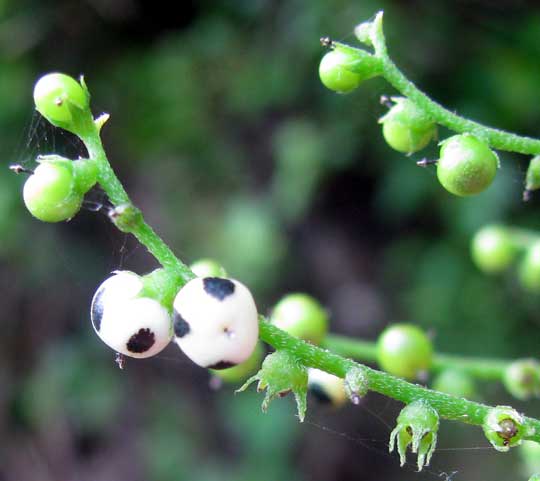Excerpts from Jim Conrad's
Naturalist Newsletter
from the July 18,, 2010 Newsletter issued from Hacienda Chichen Resort beside Chichén Itzá Ruins, central Yucatán, MÉXICO; limestone bedrock, elevation ~39m (~128ft), ~N20.676°, ~W88.569°
TWINING TOURNEFORTIA
The other day Hacienda Chichén's Chef Cime invited me to lunch at his home in the village of Kaua just east of here. Most Maya villages around here developed around a cenote, or big sinkhole with water in the bottom of it, and Kaua is no exception. When you go to Kaua, you just have to visit the cenote. I was glad to do so because in cenotes often you find moisture-loving plants not found in the drier environment above. For example, there was the flowering woody vine shown below:

This is TOURNEFORTIA VOLUBILIS*, of the Borage Family, the Boraginaceae, the same family that holds the North's herbaceous bluebells, forget-me-nots and garden comfrey. The species also grows in southern Texas and Florida so it's known by the English names of Twining Soldierbush and Twining Tournefortia. What especially caught my eye about this vine was its pea-sized, white, black-spotted fruits, shown below:

Identification of the species was made easier because I could guess that the vine was a Borage Family member. The main cue for that was how the flowers and fruits grew in a zigzag fashion along one side of the inflorescence branches -- not spirally arranged, which is more typical. Also, the tips of the inflorescence branches tended to curve like a scorpion's tail. Such inflorescences are said to be "scorpioid." This trait also occurs in a few other families, but in this part of the world if you're dealing with a woody vine, the best bet is Borage Family.
Tourneforita volubilis is found from southern Texas and Florida south through Mexico, the Caribbean and Central America to northern South America. Otherwise not much information seems to be available about the species, so here we can at least announce to the world that it's here.